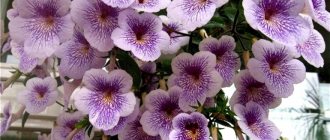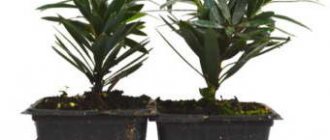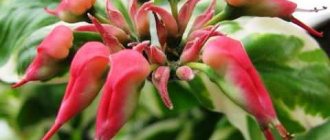The plant blooms from mid-summer to mid-autumn. It has unusual scalloped flowers with petals bent back. Gloriosa is native to the tropical zones of Africa. Found naturally in India. In Australia, Gloriosis is so widespread that it is considered a harmful weed that suppresses beneficial plants.
Also see how to grow chlorophytum at home.
| Average growth rate. Leaves grow over the course of a season. |
| Blooms from mid-summer to mid-autumn. |
| The plant is easy to grow. Suitable for a beginner. |
| Perennial. Dormant period in winter. |
Beneficial properties of gloriosa
Gloriosa is a poisonous plant. The aerial part and root of the flower contain the alkaloid colchicine, the minimum dose of which - only 0.006 g - can cause fatal poisoning. But homeopaths and pharmacologists derive benefit from toxic substances.
Colchicine, which affects the kidneys and has a detrimental effect on vision, in the right dose and in combination with the necessary components, prevents cell division and reduces the production of uric acid. When used correctly, the substance helps cope with the symptoms of gout and is used to prevent amyloidosis.
general description
Gloriosa is a climbing perennial with elegant flowers of unusual shape, bright green leaves and branched shoots, in nature reaching 2 meters. The leaves are elongated, arranged oppositely one at a time or collected in threes in a whorl; at the tip they have a kind of tendril or claw, with the help of which the gloriosa holds onto the support. If there is no support nearby, it grows like a creeping plant.
Blooming Gloriosa
Single flowers have an actinomorphic (regular) shape and are located on elongated pedicels. The perianth of Gloriosa is brightly colored and has six elongated leaflets bent upward. Their outer side is usually pink, the inner side is red, with a yellow base. Spectacular lush flowering continues all summer.
Gloriosa has underground tubers that do not overwinter, very fragile, elongated or U-shaped. Roots do not develop at the tubers, but at the base of the stems.
Gloriosis: care at home. Briefly
It is difficult for a tropical plant to take root indoors. To help acclimatize at home, create a favorable environment for gloriosis:
| Temperature | In winter – no higher than + 15°C, in summer – from + 20°C. |
| Air humidity | Increased, from 65%. |
| Lighting | Diffused bright; windows facing west or east. |
| Watering | Do not water in winter; in summer water abundantly, in autumn - rarely and sparingly |
| Soil for gloriosa | Versatile floral; prepared from equal volumes of leaf soil, turf soil, and peat. |
| Feeding and fertilizer | During flowering, every 15 days, use mineral fertilizer diluted with water. |
| Gloriosa transplant | Young tubers are planted every spring. |
| Reproduction | Seeds and tubers. |
| Features of cultivation | When replanting a vine, they immediately install a support along which it will crawl. By installing the structure later, the tubers may be damaged and the stems may break. In winter, the plant needs rest. |
Air humidity
For healthy development, gloriosis requires high air humidity - 70-80%.
The easiest way is frequent spraying. But, to be on the safe side, you can place a container of water or a humidifier next to the plant.
During the flowering period, you need to ensure that drops of water do not fall on the flowers.
Gloriosa flower
Caring for gloriosa at home. Details
If you take care of the plant and care for it properly, you will be lucky to see its original flowering.
Gloriosa bloom
The flowering of domestic gloriosa is unusual and expressive.
Single drooping flowers are formed on long (up to 0.2 m) peduncles. The diameter of the flowers can reach up to 15 cm. The petals often have a two-color color (it can change during flowering) and a scalloped surface. In some species the petals are curved upward. Up to seven flowers are simultaneously formed on the shoot, which bloom in turn. Flowering occurs in summer. After it, a fruit is formed - a box with seeds.
Temperature
A tropical plant needs warmth. In order for gloriosis to develop well, home care requires controlling the temperature. The flower is kept in summer at a temperature of + 23 - 25°C. With the onset of autumn it is gradually reduced.
By winter, the mercury should drop to + 14°C. Do not allow sudden changes in temperature: the plant may die.
If you place a flower on the balcony in the summer, make sure that the gloriosa is protected from the wind.
Spraying
Gloriosa at home must be kept at high (55 - 70%) humidity. If the house is dry, the plant may not bloom. Air humidity is raised in different ways. Spraying is possible if Gloriosa does not bloom. During flowering, turn on humidifiers; An open container of water is placed next to the pot. A flowerpot with a flower is placed on a tray with wet pebbles.
Lighting
Gloriosa grows well and blooms brightly in bright, indirect light. Therefore, the container with the flower is placed on the east or west window. A window facing north is not suitable: not only is there little light there, but it is also dark. On the south window, on the contrary, it is very light.
Intense light can cause leaf burn.
Watering Gloriosa
Watering plants at home always raises many questions.
Gloriosa is considered moisture-loving, but waterlogging is extremely dangerous for it. It can withstand a short drought, but if the soil is 1/3 dry, it's time to water. Therefore, we must remember that Gloriosa needs moderate and timely watering. In summer, when the plant is actively developing and blooming, water more often and more abundantly than at other times. In autumn it gets colder and less water is needed. In winter, when the plant is resting, it is not disturbed. For irrigation, always use lukewarm, settled water. It is best to water in the evening or early in the morning: this way the moisture will be better preserved.
Gloriosa pot
The container is selected taking into account the characteristics of the plant and its dimensions. When buying a pot for gloriosa, you must remember that the plant will not bloom in a spacious container. Young nodules, separated from the mother tuber, are planted in pots whose diameter does not exceed 150 mm.
Next, the width of the flowerpot is selected taking into account the size of the tubers; height - taking into account the size of the planting material and the height of the drainage layer.
Priming
Gloriosa needs a breathable nutrient substrate that has a neutral degree of acidity. You can prepare the soil at home and make a soil mixture from equal parts of turf soil, peat and leaf soil.
You can buy universal primer for flowers in the store. Vermiculite, brick chips, and foam balls are added to any of the substrates at home to make it more loose.
Feeding and fertilizer
During the flowering period, Gloriosa needs fertilizing and fertilizers to prolong the process, increase the number of buds and give them greater brightness. The procedure is carried out every 15 days after evening watering (then the plant is shaded for a day).
Use universal mineral fertilizers containing large quantities of phosphorus and potassium (fertilizers must be diluted with water 2 times). In autumn and winter, fertilizing is not carried out.
Transfer
Every spring they transplant Gloriosa.
A thick layer of drainage and part of the substrate are poured onto the bottom of the pot. Young tubers are fragile. They are separated from the mother plant and carefully, without dividing into parts, planted in a horizontal position. Planting is carried out so that the upper fragment of the tuber rises 25 mm above the ground. Install the support. Water the plant. Wait for the water to be absorbed and the soil to settle slightly. After this, add a little soil.
After planting, the plant is placed in the shade for 7 days. After 2 weeks they begin to feed.
Trimming
Gloriosa does not need pruning. The procedure does not affect the branching of the plant, but has a bad effect on flowering. Gloriosa flowers form on the tips of the shoots. Having cut them, you will have to wait a long time for flowering: a lot of time must pass for the plant to recover.
Rest period
Flowering - so original and bright - tires gloriosa. Therefore, the plant vitally needs a period of rest, which it openly declares by shedding its leaves. Leafless shoots dry out. Young growth will appear again in the spring on the surviving tuberous root. You can leave the bare vine in a flowerpot in a shaded, dry place until the end of February, then replant it in new soil.
The optimal winter temperature will be + 15 degrees. The second option is that after the vine dries, the tuber is removed from the soil. Cover it with sand or peat on all sides and store it in paper packaging at + 13 degrees. In early March, the tuber is planted in the substrate.
In this case, seedlings will appear later than when planting a potted vine. Gloriosis observes a period of rest from the second year of life. The young vine does not dry out during the winter; it is left in a pot in a cool place.
prop
Gloriosa is a vine. A plant can develop correctly and look beautiful if it has support. Nature, helping the flower, “decorated” the tips of its upper leaves with tendrils. With their help, gloriosa clings to support, protecting thin shoots and delicate flowers from fractures.
There are no tendrils on the lower part of the shoots, so a support is installed in the form of bamboo sticks, ladders with narrow rungs, a net or a tightly stretched rope, or fishing line. The most important thing is that the support must be thin so that small antennae can catch on to it.
The support is installed very carefully so as not to break the graceful shoots.
Gloriosa transplantation, substrate and storage during the dormant period
For gloriosis, substrates are selected from among nutritious and high-quality soil mixtures. This plant does not require the selection of extremely complex soil composition; it can grow quite successfully in a simple mixture of two parts humus and one part leaf soil. If desired, perlite or sand can be added to the soil to increase the looseness of the soil. Ready-made substrates with increased nutritional value are also suitable for the plant; in extreme cases, a universal substrate for indoor plants. The main thing is that it is sufficiently nutritious and coarse fiber, and that the soil reaction is neutral.
Digging up a tuber during the dormant period is an individual matter. Gloriosa can overwinter both in the soil and outside it. In this case, the conditions of detention do not change, and you should choose a storage method only according to your own convenience. The dormant period begins in September, when the plant's leaves gradually turn yellow and then the shoots dry out. By the time the plant enters the dormant stage, it should be gradually transferred to completely dry conditions. There are two ways forward:
- If you want to keep gloriosa in a pot, then simply place the containers in a dark, dry place with cool room temperature (16-18 degrees) until February-March, when you can replant.
- If you want to dig up gloriosa tubers, then after the shoots have dried, they must be removed from the soil, cleaned, placed in peat or sand and in a paper box or bag and stored in the refrigerator at a temperature of 8-12 degrees. Such tubers are also transplanted back into the substrate in February-March.
The difference in these strategies affects the pace of development. When stored in the soil, Gloriosa begins to grow in about 2 weeks, but when dug up and kept cool, it can take much longer before growth begins.
Regardless of age, Gloriosa is replanted every year when dug out from the substrate and, as necessary, when wintering in the ground. The procedure is carried out at the end of February or beginning of March, stimulating the awakening of the kidneys. The procedure itself is not too complicated. Unlike many indoor plants, Gloriosa requires a complete replacement of the soil. When replanting, a high layer of drainage (from 5 cm) must be laid at the bottom of the container. Thanks to the formed tuber, the vine is planted much like classic bulbous plants.
The gloriosa tuber must be placed strictly horizontally, so that about 2-3 cm of soil remains from its top to the top of the substrate layer. Particular care must be taken when handling the only bud, which is located at the rounded end of the tuber. But with all rhizomes you need to be as careful as possible. Like shoots, the Gloriosa tuber is very fragile and cannot withstand any damage; even a small injury can lead to the death of the entire plant.
After transplantation, the vine must be given careful care. The awakening of the plant must be artificially stimulated. Immediately after transplantation, Gloriosa is placed in a temperature range of 15 to 20 degrees Celsius, in transitional conditions slightly warmer than winter, and in bright light. The soil must always be kept slightly moist until the plant produces new shoots. From the moment the shoots grow, plants begin to gradually adapt to familiar conditions and higher levels of substrate and air humidity.
It is worth paying attention to the containers for this beauty. Gloriosa prefers to grow in ceramic pots rather than plastic containers. In this case, the diameter of the pot must be larger than its height. Gloriosa will not bloom in containers that are too deep, as well as in large containers.
Gloriosa is luxurious. © Delondiny
Reproduction of Gloriosa
At home, Gloriosa is propagated in two ways.
Growing Gloriosa from seeds
The lesson is long, the result does not always coincide with expectations. The seeds have low germination; seedlings develop with difficulty. A day before planting, the seeds are soaked in a solution of a growth stimulator. Planted in the ground, deepening by 0.5 mm. Cover with film and germinate in a warm place at + 23°C. Ventilate the seedlings daily; water when the soil dries out. You will have to wait about a month for germination. When 2 pairs of leaves are formed, the strengthened plant is replanted.
Reproduction of Gloriosa by tubers
The method of propagating gloriosa by tubers is used more often: it is more effective. Small, fragile tubers are carefully separated from the adult mother plant. They are planted in a loose soil mixture, pointing the growth point upward. Immediately install a support so as not to damage the tubers later. Sprout with lower heating without watering. Watering begins when the shoots appear. The grown plant is transplanted into a large container.
A plant obtained from seed will bloom in about two years. It will not retain the varietal properties of the mother plant.
Medium-sized varieties of nymphs
Medium-sized water lilies have a flower diameter of 15-20 cm. They are planted in a small lake or artificial reservoir to a depth of 30-40 cm. Such water lilies occupy from 1.2 to 1.5 sq.m of water surface.
Medium-sized nymphs are distinguished by a huge variety of varieties with flowers of different colors. These aquatic plants bloom from early summer until frost.
The most popular varieties of this group: Gonnere, Pink Dawn, Lemon Meringue, Hidden Violet.
Diseases and pests
If gloriosa is not cared for conscientiously, it may develop diseases, and it will be easier for pests to attack a weak plant. Trouble manifests itself in the form of different symptoms:
- Gloriosa bulbs rot - a consequence of waterlogging (the tuber is cleaned of damage, treated with a fungicidal agent and sprinkled with coal powder; if this happens in winter, the tuber is left for storage; at other times, it is planted in the ground);
- the leaves drooped and lost turgor - a sign of root rot from excess moisture;
- Gloriosa does not bloom - lack of light, a spacious pot, damage to the tuber due to improper storage (move to a bright place; transplant into a tighter pot; try sprinkling with charcoal powder or smearing with aloe juice, dry and plant);
- leaves turn pale - there is not enough light (move to a brighter place);
- Gloriosa leaves have darkened - due to sharp temperature fluctuations, drafts (move to a place protected from the wind);
- gloriosis grows slowly - sudden change in temperature;
- Gloriosa leaves turn yellow - due to low air humidity (spray if Gloriosa does not bloom; place on a tray with wet pebbles);
- white coating on the leaves - from watering with hard water (settle the water, sometimes add citric acid or lemon juice to it - 0.2 g or 3 drops per liter of settled water).
Often a weakened plant is affected by spider mites, scale insects, and aphids. The pests are washed off with a shower, and the plant is treated with an insecticide.
Location and lighting
You should choose a place in the room where the flower will not be disturbed by drafts. The volume of the container in which the plant is placed also matters. Gloriosa will not bloom in a large and spacious pot. Young tubers should be placed in a pot with a diameter of no more than fifteen centimeters.
As for lighting, it must be said that you will have to find a middle ground - a lack of light will make the foliage pale and dull, and direct sunlight will cause burns. The best place for a flower in a room will be a window sill facing west or east.
In the warm season, gloriosa can be placed on the balcony, making sure to tie the shoots to a support and protect them from the rays of daylight.
Types of Gloriosa domestica with photos and names
In the natural environment, different types of gloriosis occur. At home, one species and its varieties are mainly common.
Gloriosa luxurious, or magnificent (Gloriosa superba)
Long (up to 200 cm) vine with thin shoots. Pale green leaves have a shiny surface. Their length reaches 100 mm, width – 30 mm. The tip is pointed. Flowers with long (up to 80 mm) scalloped petals with a peculiar color are formed in the axils of the leaves: on the outside they are salmon-colored with a pink tint. The inner side is scarlet on top, golden on the bottom. Blooms all summer.
Popular varieties
The most common varieties of luxurious gloriosa are:
Luxurious yellow Gloriosa (Gloriosa Lutea)
Low-growing (up to 0.9 m) plant with bright lemon flowers.
Gloriosa Carsonii
A low plant with flowers of double color: violet-brown petals with a golden edge.
Gloriosa Luxurious Grena (Gloriosa Greenii)
The surface of the leaf plate is not scalloped, but absolutely smooth. Long (up to 85 mm) rich yellow petals, curled outward, look like lanterns.
Rothschild's Gloriosa (Gloriosa Rothschildiana)
The height of the vine exceeds 200 cm. The large flowers at the edges are rich lemon, in the center they are carmine red.
Gloriosa modesta (Gloriosa modesta)
Medium sized liana (less than 200 cm). The leaf blades are bright green in color. Large drooping flowers are yellow with an orange tint. Their surface is glossy.
The exotic tropicana is capricious and requires special care. Therefore, gloriosis is rarely found in apartments. If a flower is lucky with a caring and patient owner, it will not remain in debt and will repay with bright, unusual blooms.
Currently reading:
- Eucharis - home care, photos of species, transplantation
- Wallota - growing and care at home, photos of species
- Stefanotis - home care, photo. Can I keep it at home?
- Alocasia domestica. Growing and care
- Oleander
Kinds
There are not so many varieties of this charming plant. The most common indoor plants are:
- luxurious (also called magnificent);
- simple;
- daisy or rudbeckia;
- Rothschild's gloriosis.
The most popular variety is Gloriosa splendid, bearing fruit with large seeds. Wavy flowers and greenish-yellow petals up to five centimeters long are characteristic features of Gloriosa simplex.
Long petals (up to ten centimeters) of a crimson hue and scarlet spots at the bottom distinguish the Rothschild variety. Rudbeckia is an annual plant, and its appearance resembles a huge chamomile.
Transplanting a plant
Strelitzia flower: examples of care and cultivation at home
The plant's dormant period ends in the last days of February - early March. It is at this time that it is necessary to inspect the tubers more carefully. With the first signs of bud awakening, the plants are transplanted into a new container.
Healthy. During the period of active growth, gloriosis consumes nutrients from the soil in large quantities, so they need to be replenished regularly for the plant to feel comfortable.
For transplantation, you should choose containers that are not very deep, but elongated. It is desirable that the diameter be from 14 to 18 centimeters. The prepared substrate is poured into the container, and the plant tuber is planted to a depth of 3 cm.
Gloriosa transplant
There must be drainage at the bottom of the container. After a complete transplant, it is necessary to tie up the plant so that it recovers faster and begins to grow.
Features of flowering and problems
Gloriosa usually blooms from June to September. Each flower lasts for about two weeks and is replaced by a new one. Therefore, the plant retains its attractive appearance for a long time.
Blooming Gloriosa
Why Gloriosa does not bloom:
- lack of sunlight;
- drafts;
- poor-quality soil, depleted of nutrients;
- improper wintering, for example, at too low a temperature;
- disease or damage to the tuber.
Activity and rest
The period of activity begins with the arrival of spring, when the tubers are planted in the soil. With proper care, the first flowers will appear at the beginning of summer. In September they wither, gradually wither and the leaves fall off. In a young plant, the above-ground part of the plant may not die off in the first year. Then there is no need to dig up the tubers; you should continue to care for the flower, reducing watering and providing warmth and light.
Types and shape of flowers
Different types of gloriosis differ in appearance. The shape of the petals is preserved, but they are not similar in size, length, edges, but are always thin and elongated. Their color changes from yellow to scarlet. There are petals of purple, soft pink, and orange. The buds themselves differ in size, some reach 10-15 cm in diameter, others do not exceed 3 cm.
Use and application
More often, the red water lily is used by humans for decorative purposes. It is specially grown in ponds for aesthetic pleasure.
However, its parts (rhizome, stems, leaves) are used as medicines for internal (infusions, decoctions) and external use (ointments, compresses, infusions). It has a hemostatic, anti-inflammatory, antipyretic, analgesic, and sedative effect. Fans of traditional medicine can find many uses for the water lily, but before doing so, they definitely need to consult a knowledgeable doctor. Otherwise, the desired improvement may result in even greater harmful consequences for the body. It is also important to remember that preparations from various parts of water lilies are contraindicated for people with low blood pressure (hypotension).
Water lilies of various types are also eaten. Nymphea seeds are used as a coffee substitute, and the rich, fleshy rhizomes are used to produce starch and flour.











